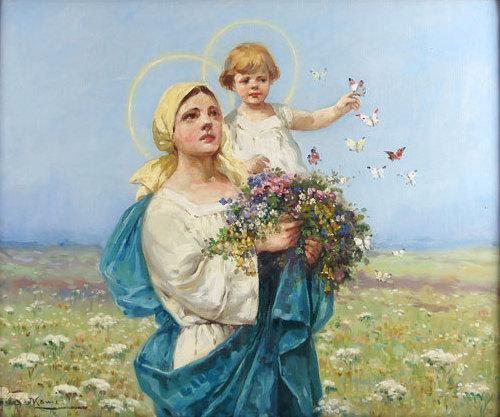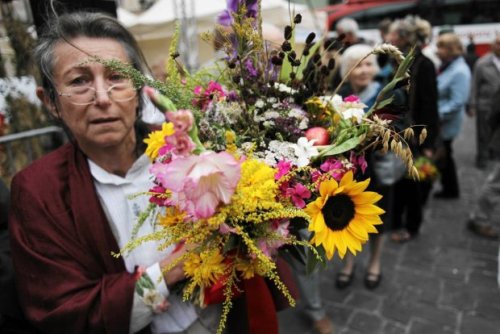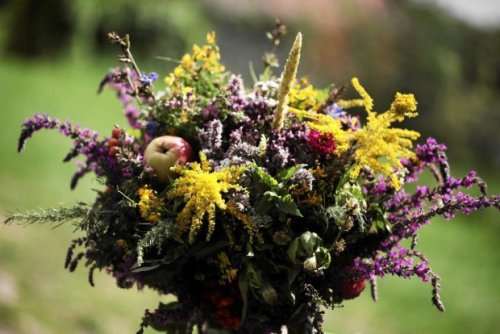August 15th - The Assumption of the Virgin Mary into Heaven/The Feast of Our Lady of HerbsIn Poland
August 15th - The Assumption of the Virgin Mary into Heaven/The Feast of Our Lady of HerbsIn Poland this day is commonly known as The feast of Our Lady of Herbs. In days prior to the feast, people collected herbs, especially those of medical utility, (like st. John’s wort, Thymus, Salvia, Artemisia, wormwood, wild ginger, yarrow, tansy, mullein, Anethum, Carum, Rumex, henbanes, Rosmarinus , mint, Melissa, Myrtle, rue, periwinkle, monkshood). Along with garden flowers (like Dahlia, Centaurea, marigolds, hollyhocks), papaver, wheats, fruits (usually apples or late cherry) and veggetables, cannabis and linum, they were put into bouquet and brought to church on the day of the Feast. During Mass priest blessed them saying: Oh, Lord, protect those herbs and emblements from destruction, so they would grow, brought us joy, and many crops to harvest, and so they would serve well-being of people and animals. And when we will be leaving this world, let us, bearing the harvests of good deads, be introduced to You, oh Lord, by the Virgin Mary assumed to Heaven, the most excellent fruit of the Earth, so we could join the eternal glory. People believed this way they gained special protecting and healing power. Coming back home from church, people left those bouquets on fields for few days, to spread their protective power over crops remaining still there. Later they were brought to household, where part was fed to animals, to protect and heal them, and rest was kept stocked behind paintings on the wall or on the window - for the further use in case of illness or epidemic (in form of brew or fumes were applied to both animals and humans), but also against some potential disaster, like thunderstorm, hail, fire. What was left of it after a year was burned to ashes and added to seeds for next harvest. There’s many legends and theories explaining connection between Mary, Mother of God, and flowers, herbs and harvests. For example, there’s the story of Her „death”, as quoted by st. John of Damascus. In time of Her falling asleep, all the Apostoles were gathered around her. Well, except for st. Thomas Didymus. They put her body into grave and closed the entrance with large rock – just like during the burial of Jesus Christ. After three days, st. Thomas finally arrived, and wished to see her body – one last time. But when they opened the grave, it was empty. In place where once lied Mary’s body, now was a pile of flowers. Other story speaks about time when Holy Family was escaping to Egipt. On their route they run across a farmer sowing his field. They helped him, and so every seed - right after it was dumped into soil - grew large and ready to harvest. When Herod’s soldiers pursuing the Holy Family came, they asked the farmer, did he saw a young woman with a little child? And so he answered: Yes, I saw them when I was sowing this field. Looking at the field, soldiers assumed it must have been months ago, so they gave up and turned back home… Sources:www.pijarzy.plwww.religie.424.pl/swieto-matki-boskiej-zielnej,1823,article.htmlethnomuseum.pl/blog/2011/08/15/ziele-na-swieto-matki-boskiej-zielnej/brewiarz.katolik.pl/czytelnia/swieciPictures:1. Matka Boża Zielna, Adam Setkowicz (1876 - 1945) [x]2-3. Celebration of the Feast of Our Lady of Herbs, in Cracow, Poland. [x]4-5. some bouquets examples [x] [x]6. Figure of Our Lady decorated with wheats, [x] -- source link
Tumblr Blog : weirdpolis.tumblr.com
#polish tradition#folk culture#herbs#ethnology#poland#religious#celebrations




